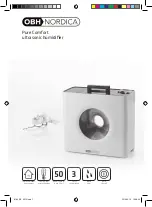
To bear in mind
The wet air hose must not be replaced with one with smaller dimensions.
If
this occurs, the installation's function is affected and the dehumidi-
fier can overheat.
c) Connection of control panel, (hygrostat section)
The hygrostat is placed in the crawl space where the conditions are
considered suitable or particularly critical. It must not be located in
a position where it is exposed to the dry air. It must not be located
near sources of heat or cold or exposed to solar radiation.
The mois-
ture sensor
must be removed from its transport cover and hang
freely from its cable.
d) Connection of control panel (indicator box)
The indicator box must be placed in a suitable location in the house
where it can be easily monitored. To avoid unnecessary electrical
routing it should be as close to the dehumidifier/hygrostat as pos-
sible.
6. OPERATION AND CARE
a) Start
The machine should be checked immediately after receiving it.
Faults and transport damaged parts must be reported immediately.
1.
Check that
the filter
is clean
2. Check that there are no blockages in the connected duct system
3. Connect the dehumidifier to an earthed electrical socket 230V. An earth fault breaker
should be used.
4. Does the rotor rotate? Look through the dry air opening.
5. Check the temperature of the wet air, which is significantly hotter than process air
during dehumidifying.
6.
Follow the dehumidifier's function. Note in the service journal.
- 7 -
Moisture






























